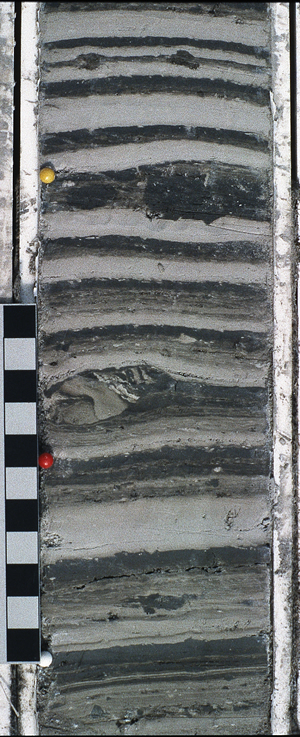Varves of the Month for 7/1/2008 - 7/31/2008
Champlain Valley varves at Keesville, NY
This image shows glacial varves from the Champlain Valley of New York. The winter or non-melt season layers are the dark clay-rich layers while the summer or melt season layers are lighter and composed of dominantly fine sand and silt. The varves were deposited within 2 decades of ice recession at approximately 13,500 years ago in Lake Vermont. Sedimentation at Keesville was still dominantly controlled by the input of sediment from the receding glacier. Varve thickness decreases upward as a result of ice sheet recession.
Summer or melt season layers (light-colored units) are composed of a stack of graded to micrograded units of fine sand and silt with some clay that become increasingly less sandy and darker upwards. Most summer layers are dominated by a sandy basal unit. This initial summer event may represent the summer's major precipitation or melting events. The upper part of the summer layer grades into the winter layer. Summer layer thickness is greater than winter layer thickness and also varies much more than winter layer thickness in these varves. In this image summer and winter layer thicknesses do not always vary proportionally. Occasional fine sand and silt partings in the winter layers suggest that clay deposition may actually start during the later part of the melt season while storm or melting events still have the ability to disperse some coarse sediment.
A conspicuous feature of the Keesville varves is abundant ice-rafted or drop sediment. Recession of the last ice sheet in the Champlain Valley, as well as the Mohawk Valley of central New York, involved rapid calving in deep lakes resulting in abundant ice-rafted debris. The ice-rafted sediment in this image is dominantly in the form of pellets of non-lithified sediment rather than dropstones. This type of drop sediment is likely the result of calving of icebergs that had adhering sediment from the bed of the glacier or contained sediment frozen into them. The very light gray and silty pellets appear to be chunks of rock flour. There are also many other fragments that appear to have internal bedding with greatly varying sediment types (see the large chunk in the middle of the image), possibly the result of overridden lake sediment frozen into the glacier. The ice-rafted sediment seems to be much more abundant in the later (finer) parts of the summer layer and in the winter layer. The early, light, and generally coarser part of the summer has very little drop sediment, probably because of its much higher sedimentation rate.
Past Varves of the Month...
- 6/1/2008 - Connecticut Valley Varves at Canoe Brook, Dummerston, Vermont
- 4/27/2008 - Connecticut Valley Varves from Kelsey Ferguson Brickyard, Redland Brick Co., East Windsor, Connecticut.
- 8/1/2008 - Connecticut Valley Varves at Aldrich Brook, Westmoreland, New Hampshire
- 9/1/2008 - Connecticut Valley Varves, Perry Hill Basin (PHS), Charlestown, New Hampshire
- 10/1/2008 - Connecticut Valley Varves, Perry Hill Basin (PHN), Charlestown, New Hampshire.
- 11/1/2008 - Connecticut Valley Varves, Aldrich Brook site, Westmoreland, New Hampshire
- 12/1/2008 - Connecticut Valley Varves, Aldrich Brook site, Westmoreland, New Hampshire
- 1/1/2009 - Mine fire reclamation site, Olyphant, Pennsylvania
- 2/1/2009 - Connecticut Valley Varves, Perry Hill Basin (PHS), Charlestown, New Hampshire
- 3/1/2009 - Connecticut Valley Varves, Perry Hill Basin, Charlestown, New Hampshire
- 4/1/2009 - Connecticut Valley Varves, Perry Hill Basin, Charlestown, New Hampshire.
- 5/1/2009 - Connecticut Valley Varves, Perry Hill Basin, Charlestown, New Hampshire
- 6/1/2009 - Connecticut Valley Varves, Perry Hill Basin, Charlestown, New Hampshire
- 7/1/2009 - Connecticut Valley Varves, Perry Hill Basin, Charlestown, New Hampshire
- 8/1/2009 - Connecticut Valley Varves, Perry Hill Basin, Charlestown, New Hampshire
- 9/1/2009 - Connecticut Valley Varves, Perry Hill Basin, Charlestown, New Hampshire
- 10/1/2009 - Connecticut Valley Varves, Perry Hill Basin, Charlestown, New Hampshire
- 11/1/2009 - Connecticut Valley Varves, Perry Hill Basin, Charlestown, New Hampshire.
- 12/1/2009 - Connecticut Valley Varves, Perry Hill Basin, Charlestown, New Hampshire
- 1/1/2010 - Connecticut Valley Varves, Perry Hill Basin, Charlestown, New Hampshire
- 2/1/2010 - Varves along Starrucca Creek near Lanesboro, Pennsylvania
- 3/1/2010 - Varves in the Don Valley, Toronto
- 4/1/2010 - Varves along Sandy Stream, Dennistown Plantation near Jackman, Maine
- 5/3/2010 - Varves from Glacial Lake Great Falls in Montana
- 6/4/2010 - Varves from Charlestown, NH
- 7/1/2010 - Varves from Redlands Brick Co. (Kelsey Ferguson Brickyard, South Windsor, Connecticut) - A varve that Antevs missed
- 8/1/2010 - Varves from Glastonbury, Connecticut
- 9/1/2010 - Varves from North Hatfield, Massachusetts
- 10/1/2010 - Varves from Newbury, Vermont
- 11/1/2010 - Varves from Newbury, Vermont
- 12/1/2010 - Varves from Newbury, Vermont
- 2/1/2011 - Connecticut Valley Varves at North Hatfield, Massachusetts
- 3/1/2011 - Connecticut Valley Varves Kelsey Ferguson (Redlands Brick Co.), South Windsor, Connecticut
- 6/1/2011 - Connecticut Valley Varves: Core at Scantic, East Windsor, Connecticut
- 8/1/2011 - Varves of West Canada Creek Valley, western Mohawk Valley
- 10/1/2011 - Varves of West Canada Creek Valley, western Mohawk Valley collected in Newport, NY
- 12/1/2011 - Connecticut Valley Varves at Claremont Junction, NH
- 3/1/2012 - Connecticut Valley Varves at Westmoreland, NH
- 7/1/2012 - Connecticut Valley Varves at Rt. 12A drill site in North Charlestown, N.H.



